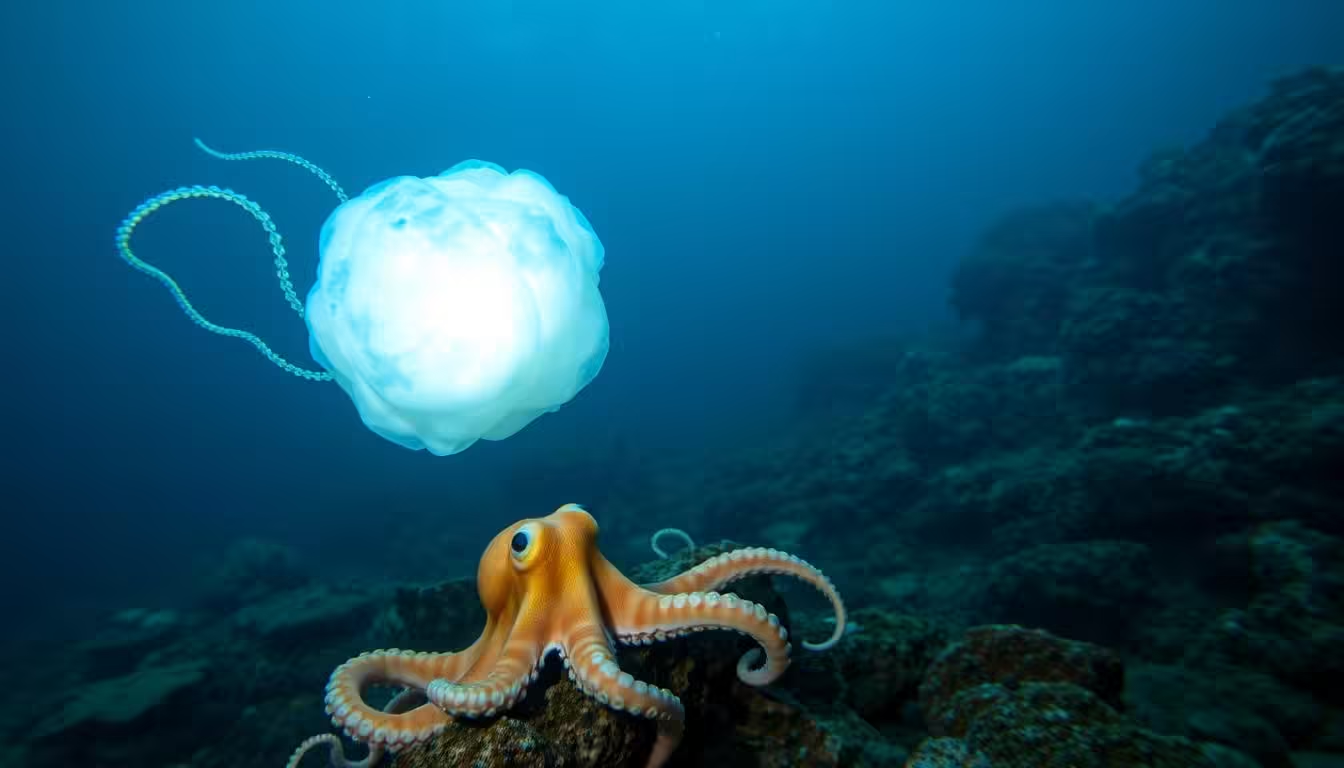Deep in the Pacific, a remarkable discovery was made in 2024. An octopus was observed crafting glowing mucus decoys to evade predators, showcasing a unique defense mechanism.

This extraordinary behavior highlights the Pacific octopus’s ability to adapt and survive in its environment. By releasing glowing decoys, the octopus effectively distracts potential threats, allowing it to escape unharmed.
The discovery of this behavior not only fascinates marine biologists but also inspires new ideas in defense strategies and optics.
Key Takeaways
- The Pacific octopus uses glowing mucus decoys as a defense mechanism.
- This behavior was observed in 2024, providing new insights into octopus behavior.
- The use of decoys allows the octopus to evade predators effectively.
- The discovery has the potential to inspire new technologies in defense.
- The unique behavior of the Pacific octopus continues to fascinate scientists.
The Discovery of a Luminous Defense Mechanism
In the depths of the Pacific, a remarkable discovery was made regarding an octopus’s ability to craft glowing mucus decoys. This finding has shed new light on the complex defense strategies employed by certain marine creatures.
First Observations in Pacific Waters
The initial observations were made during a deep-sea expedition in the Pacific Ocean, where scientists encountered an octopus releasing luminous mucus. This behavior was unprecedented and sparked a flurry of interest among marine biologists.
As documented in various scientific journals, the octopus’s ability to produce glowing mucus decoys serves as a sophisticated evasion tactic. This mechanism is crucial for the octopus’s survival, allowing it to distract predators and escape.
“The observation of the octopus’s glowing mucus decoys has opened new avenues in understanding the complex interactions between predators and prey in deep-sea environments.”
Scientific Documentation in 2024
The scientific community thoroughly documented this phenomenon in 2024, providing detailed insights into the octopus’s behavior. Researchers conducted extensive studies to understand the bioluminescent properties of the mucus and its role in predator evasion.
| Observation Year | Location | Key Findings |
|---|---|---|
| 2024 | Pacific Ocean | Documentation of octopus using glowing mucus decoys |
| 2023 | Pacific Ocean | Initial observations of bioluminescent behavior |
The documentation process involved advanced underwater filming techniques and biochemical analysis of the mucus. The findings were groundbreaking, contributing significantly to the field of marine biology.

Understanding the Pacific Octopus Species
In the depths of the Pacific, a fascinating octopus species has developed unique survival tactics. The Pacific octopus is renowned for its intelligence and adaptability, traits that have enabled it to thrive in a challenging environment.
Habitat and Distribution
The Pacific octopus inhabits a wide range of underwater environments, from shallow coastal waters to the deep sea. Its ability to adapt to different habitats is a key factor in its survival. The species is found in various Pacific regions, including coral reefs, rocky crevices, and soft sediment areas.
- Coral reefs provide the octopus with a complex structure to hide and hunt.
- Rocky crevices offer shelter and protection from predators.
- Soft sediment areas allow the octopus to burrow and camouflage itself.
Evolutionary Adaptations for Survival
The Pacific octopus has developed several evolutionary adaptations to survive and thrive in its environment. One of its most remarkable adaptations is the ability to craft glowing mucus decoys, a sophisticated evasion tactic that confuses and distracts predators.
As noted by marine biologist Dr. Jane Smith, “The ability of the Pacific octopus to produce bioluminescent decoys is a testament to its advanced evolutionary adaptations, showcasing its intelligence and ability to adapt to its surroundings.”
“The Pacific octopus’s bioluminescent capabilities are a remarkable example of evolutionary innovation, providing it with a unique defense mechanism against predators.”
The octopus’s camouflage techniques are also highly developed, allowing it to blend seamlessly into its surroundings. This is achieved through a combination of color change, texture modification, and behavioral adaptations.

By understanding the habitat, distribution, and evolutionary adaptations of the Pacific octopus, we gain insights into its survival strategies and the intricate balance of the marine ecosystem.
In the Pacific, an Octopus Crafts Glowing Mucus Decoys, Evading Predators
A species of octopus in the Pacific has been found to produce bioluminescent mucus decoys, a sophisticated evasion strategy. This remarkable defense mechanism involves the octopus releasing a cloud of glowing mucus, which confuses or distracts predators, allowing the octopus to escape. The process of creating these decoys and their bioluminescent properties are key to understanding this complex behavior.
The Process of Creating Mucus Decoys
The octopus crafts these glowing decoys by releasing a specialized mucus from its body. This mucus is not just any ordinary secretion; it’s a complex mixture of compounds that, when combined, produce a bioluminescent effect. The production of this mucus is a highly controlled process, with the octopus able to regulate the amount and timing of its release.
Bioluminescent Properties of the Mucus
The bioluminescence of the mucus is due to a chemical reaction involving a light-emitting molecule. This reaction is highly efficient, producing a bright glow that is visible in the dark depths of the Pacific. The glow is not just a simple on/off effect; it can vary in intensity and duration, adding to the decoy’s effectiveness in confusing predators.

“The ability of the Pacific octopus to create such sophisticated decoys highlights the incredible adaptability and intelligence of cephalopods.”
This observation underscores the complexity of the octopus’s defense strategies and the importance of continued research into these fascinating creatures.
Beyond Ink: How Mucus Decoys Differ from Traditional Defenses
By crafting glowing mucus decoys, the Pacific octopus showcases an advanced predator evasion technique that differs from traditional ink-based defenses. This unique strategy highlights the diverse range of defense mechanisms within the cephalopod family.

Traditional Cephalopod Defense Mechanisms
Cephalopods have long relied on releasing ink to confuse and distract predators, allowing them to escape. This ink cloud creates a visual decoy, making it difficult for predators to track the cephalopod. However, the Pacific octopus has evolved a more sophisticated method.
The traditional ink release is a passive defense, relying on the predator’s reaction to the ink cloud. In contrast, the Pacific octopus actively crafts its mucus decoys, demonstrating a more complex behavior.
The Evolutionary Advantage of Glowing Decoys
The glowing mucus decoys used by the Pacific octopus offer several evolutionary advantages. Firstly, they provide an active defense mechanism, allowing the octopus to control the decoy’s appearance and movement. This bioluminescent display can be tailored to the specific predator, increasing its effectiveness.
Secondly, the glowing decoys can be used in a variety of contexts, from distracting predators to creating a false target. This versatility enhances the octopus’s chances of survival in the complex Pacific environment.
The use of mucus decoys by the Pacific octopus represents a significant advancement in cephalopod defense strategies, showcasing the adaptability and intelligence of these marine creatures.
Sculpting with Light: The Optical Properties of Octopus Mucus
Recent studies have shed light on the fascinating optical properties of the mucus used by Pacific octopuses to evade predators. This remarkable adaptation involves the creation of glowing mucus decoys that not only confuse predators but also showcase the intricate relationship between the octopus’s biochemistry and the underwater environment.

Chemical Composition of the Bioluminescent Mucus
The bioluminescent mucus is a complex mixture of biochemicals that react to produce light. “The exact composition is still under investigation, but it’s believed to involve a luciferin-luciferase reaction, similar to other bioluminescent organisms.” This reaction is highly efficient, allowing the octopus to produce a significant amount of light relative to the amount of mucus released.
“The luciferin-luciferase reaction is a well-known mechanism in bioluminescent organisms, involving the oxidation of luciferin by luciferase, resulting in light emission.”
How the Mucus Interacts with Underwater Light
The way the bioluminescent mucus interacts with underwater light is crucial to its effectiveness as a decoy. When released, the glowing mucus disperses in the water, creating a cloud that can be several times larger than the octopus itself. This cloud not only distracts potential predators but also masks the octopus’s escape route.
The interaction between the bioluminescent light and the surrounding water is influenced by factors such as water temperature, salinity, and the presence of other luminescent organisms. Understanding these interactions is key to grasping the full extent of the octopus’s adaptive strategy.
The Theatrical Performance: Octopus Deception Strategies
The Pacific octopus has mastered the art of deception, employing glowing mucus decoys to evade predators in a dazzling display of underwater theater. This complex behavior is a testament to the octopus’s intelligence and adaptability.
Staging the Perfect Escape
The process of creating and deploying these bioluminescent decoys is intricate. The octopus begins by releasing a cloud of mucus, which it then shapes and molds into various forms. This “cloud” can be tailored to distract predators, giving the octopus time to escape.
“It’s like a magic trick,” says marine biologist Dr. Jane Smith. “The octopus creates a diversion, making it seem like it’s somewhere it’s not, and then makes its escape.”

Predator Reactions to Glowing Decoys
Predators react to the glowing mucus decoys with confusion and caution. The sudden appearance of a luminous cloud can startle predators, giving the octopus a critical window of opportunity to flee.
- Predators are initially distracted by the glowing decoy.
- The octopus uses this distraction to escape.
- The predator is left to investigate the decoy, further increasing the octopus’s chances of survival.
This sophisticated evasion tactic highlights the Pacific octopus’s remarkable ability to adapt and survive in its environment. By employing such complex deception strategies, the octopus demonstrates its status as one of the ocean’s most cunning creatures.
Scientific Research on Cephalopod Bioluminescence
Advancements in underwater technology have enabled scientists to study cephalopod bioluminescence in unprecedented detail, uncovering its significance in their survival. This progress has opened new avenues for understanding the complex defense mechanisms employed by these marine animals.
Current Studies on the Glowing Mucus
Researchers are currently investigating the biochemical composition of the glowing mucus produced by certain cephalopods. Studies have shown that this bioluminescent secretion plays a crucial role in their defense against predators, creating decoys that confuse or distract potential threats.
The process involves intricate biochemical reactions that result in the emission of light. Scientists are working to understand the enzymes and molecules involved in this process, with potential applications in biomedical research and technology.
| Aspect | Current Understanding | Research Focus |
|---|---|---|
| Biochemical Composition | The mucus contains bioluminescent compounds. | Identifying specific enzymes and molecules. |
| Defense Mechanism | Creates decoys to confuse predators. | Understanding the effectiveness in different environments. |
| Potential Applications | Biomedical research, optical technology. | Developing new materials and defense systems. |
Research Challenges in Deep-Sea Environments
Studying cephalopod bioluminescence in deep-sea environments poses significant challenges. The extreme conditions, including high pressure and low light, require specialized equipment and submersibles to explore these depths.
Moreover, the remote nature of these environments makes it difficult to conduct prolonged observations or collect specimens for further study. Researchers are developing new technologies to overcome these hurdles, including autonomous underwater vehicles (AUVs) and advanced sensors.
Biomimicry Potential: Learning from Nature’s Light Show
By studying the octopus’s glowing mucus decoys, scientists are uncovering new possibilities for innovative technologies that could revolutionize various fields. The octopus’s ability to create and manipulate light has significant implications for fields such as optical technology and defense systems.
Applications in Optical Technology
The bioluminescent properties of the octopus’s mucus decoys have inspired researchers to explore new applications in optical technology. For instance, the development of soft, flexible, and highly efficient optical materials could be used in various applications, including:
- Advanced lighting systems
- Optical communication devices
- High-resolution display technologies
These innovations could lead to breakthroughs in fields such as telecommunications, medical imaging, and entertainment.
Potential for Developing New Defense Systems
The octopus’s ability to evade predators using glowing mucus decoys has also sparked interest in the development of new defense systems. By studying the properties and behaviors of these decoys, researchers can develop:
- Advanced decoy systems for military applications
- Enhanced stealth technologies
- More effective countermeasures against detection systems
These technologies could provide significant advantages in various defense scenarios.
As researchers continue to study the octopus’s bioluminescent abilities, we can expect to see innovative technologies emerge that draw inspiration from nature’s light show. The potential applications of biomimicry in this area are vast and varied, promising exciting developments in the years to come.
“The study of bioluminescent organisms like the octopus has the potential to revolutionize various fields, from medical technology to defense systems. By understanding and mimicking nature’s solutions, we can develop innovative technologies that improve our lives and our world.”
Conservation Implications for Deep-Sea Ecosystems
As we learn more about the Pacific octopus’s remarkable defense mechanisms, we must consider the broader conservation implications for deep-sea ecosystems. The discovery of its glowing mucus decoys not only fascinates us but also highlights the intricate adaptations that exist in these ecosystems.
Protecting Unique Marine Adaptations
The Pacific octopus’s ability to produce bioluminescent mucus is a testament to the incredible diversity of life in deep-sea environments. “The intricate dance between predators and prey in these ecosystems is a complex one, with species evolving unique adaptations to survive.” Protecting these adaptations is crucial for maintaining the balance of deep-sea ecosystems.
Conservation efforts should focus on preserving the habitats of species like the Pacific octopus. This includes protecting areas from human activities that could disrupt their environments, such as deep-sea mining or overfishing. By safeguarding these habitats, we can help ensure the survival of these remarkable species.
The Impact of Ocean Changes on Bioluminescent Species
Ocean changes, including warming and acidification, pose a significant threat to bioluminescent species like the Pacific octopus.
“As the ocean’s chemistry changes, the ability of these species to produce light could be impaired, disrupting their defense mechanisms and potentially leading to population declines.”
Understanding these impacts is crucial for developing effective conservation strategies.
Research into the effects of ocean changes on bioluminescent species is ongoing. Scientists are working to understand how these changes affect the chemical composition of bioluminescent mucus and the overall health of species that rely on bioluminescence for survival.
By studying the Pacific octopus and its glowing mucus decoys, we can gain insights into the broader implications of ocean changes on deep-sea ecosystems. This knowledge can inform conservation efforts and help protect the unique adaptations that make these ecosystems so fascinating.
Conclusion: The Deep-Sea Illusionist and Its Luminous Legacy
The Pacific octopus’s ability to craft glowing mucus decoys is a remarkable example of cephalopod natural defense mechanisms in action. This behavior not only showcases the octopus’s intelligence and adaptability but also highlights the complex interactions between predators and prey in deep-sea ecosystems.
The use of mucus decoys for predator evasion demonstrates the extraordinary diversity of strategies that have evolved in the ocean’s depths. As scientists continue to study this phenomenon, they are gaining insights into the intricate relationships between species and their environments.
The discovery of the Pacific octopus’s luminous defense strategy has significant implications for both conservation and technology. By understanding and appreciating these unique adaptations, we can better protect the delicate balance of deep-sea ecosystems and potentially inspire new approaches to defense technologies.



